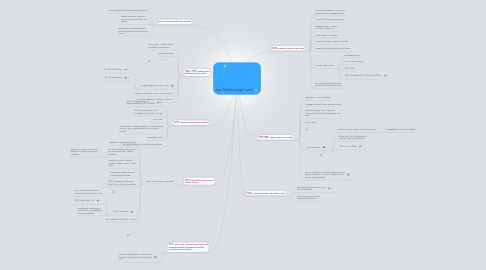
1. 1917: term "jazz" began being used, and Original Dixieland Jazz Band was first recording jazz ensemble
1.1. Storyville closed down: center of jazz moved to Chicago, Kansas City, New York
2. 1890's-1915: Ragtime was developed and popular
2.1. Piano music in duple meter, moderate march tempo
2.2. Syncopated beat
2.3. "King of Ragtime": Scott Joplin
2.3.1. Ex: Maple Leaf Rag
2.3.2. Ex: The Entertainer
2.4. AA-BB-CC-DD-EE or AA-BB-A-CC-DD forms
2.5. Ex: Eubie Blake and Charles L. Johnson
3. 1910's: Blues music became popular
3.1. 1912: The publication of Memphis Blues by W.C. Handy
3.2. 1914: the publication of St. Louis Blues also by W.C. Handy
3.3. a-a'-b form
3.4. 12-bar blues: harmonic pattern of 12 bars using only the tonic, subdominant, and dominant chords
3.5. Quadruple meter
3.6. Ex: Sippie Wallace's If You Ever Been Down
4. 1910: Storyville, New Orleans: center of jazz
4.1. New Orleans Style or Dixieland
4.1.1. Played by a small (5-8) group
4.1.2. Frontline: melodic instruments; ex: cornet, trumpet, clarinet, trombone
4.1.2.1. Polyphonic texture came from everyone of improvsing many melodies
4.1.3. Based on a march, church melody, ragtime piece, 12-bar blues
4.1.4. Sometimes breaks occured: unaccompanied solos
4.1.5. 1923: Dippermouth Blues by King Oliver's Creole Jazz Band
4.1.6. Louis Armstrong
4.1.6.1. 1925: Recording with Louis Armstrong's Hot Five or Seven
4.1.6.2. 1927: Hotter than That
4.1.6.3. Popularized scat singing: vocalization of melody with nonsense syllables
4.1.7. Ex: Ferdinand "Jelly Roll" Morton
5. Early on Brass Bands were popular
5.1. Every village had own band and bandstand
5.2. Played at picnics, parades, carnivals, political rallies, and dances
5.3. Instruments included trumpet, cornet, trombone, tuba, clarinet, drums
6. 1920's: Chicago became the blues center
6.1. Recoding by Bessie Smith: Lost Your Head Blues
6.2. Improvised jazz musicians responses to the lyrics
7. 1935-1945: Swing music was popular
7.1. "Big Band": 14-15 musicians
7.2. Arranged, notated music not improvised
7.3. Riffs were played: short, repeated phrases played by the saxophones and brass
7.4. AA-B-A form
7.5. Duke Ellington
7.5.1. Broke 3 minute barrier of 78 rpm records
7.5.1.1. Created Black, Brown, and Biege
7.5.2. Wrote Satin Doll, Sophisicated Lady, In a Sentimental Mood
7.5.3. 1942: C-Jams Blues
7.6. Ex: Count Basie, Glen Miller, Tommy Dorsey, Benny Goodman, Coleman Hawkins, Frank Sinatra, Ella Fitzgerald
8. 1940's: Bebop came on the scene
8.1. A lot of improvisation contrary to the written out, arranged swing
8.2. Meant for listening not dancing
8.3. Bebop center: in Harlem, "Minton's Playhouse"
8.4. Small groups: 4-6 players
8.5. Complex chords, complex melodies
8.6. Began and ended with the main theme
8.7. Charlie "Bird" Parker
8.7.1. alto saxophonist
8.7.2. 1944: first recordings
8.7.3. 1945: KoKo
8.7.4. 1948: with Miles Davis, Out of No Where
